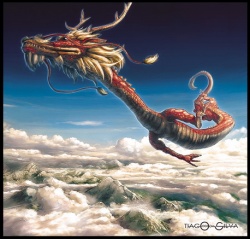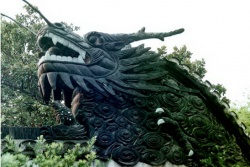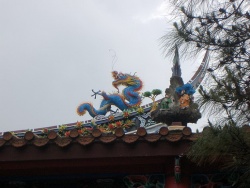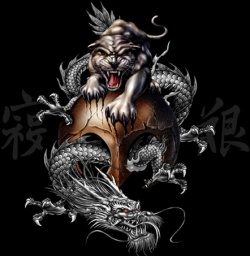Singing the Dragon Song
The Main Case
Xiangyan was once asked by a monastic, “What is the Way?”
Xiangyan said, “A dragon singing in a withered tree.”
The monastic said, “What does this mean?”
Xiangyan said, “Eyeballs in a skull.”
Later, another monastic asked Shishuang, “What is the dragon’s singing in a withered tree?”
Shishuang said, “It still has Joy.”
The monastic said, “What are the eyeballs in a skull?”
Shishuang said, “They still have senses.”
Later, another monastic asked Master Caoshan, “What is the dragon’s singing in a withered tree?”
Caoshan said, “Bloodstream has not stopped.”
The monastic said, “What are the eyeballs in a skull?”
Caoshan said, “Dry all the way.”
The monastic said, “I wonder, can anyone hear it?”
Caoshan said, “Throughout the entire Earth, there is no one who does not hear it.”
The monastic said, “Which verse does the dragon sing?”
Caoshan said, “I don’t know which verse it is, but all those who hear it are lost.”
The Commentary
Do not mistake a withered tree for a dead tree; it abounds with Life and celebrates each and every spring with new foliage. It’s just that few have realized this. As for the dragon’s song, actually, everyone is able to hear it, because it exists everywhere. And yet, there can be no dragon’s song unless there is a withered tree. If you can see through to the point of this koan and make it your own, then your own voice will be the dragon’s song and you will be able to make use of it among the ten thousand things. If, however, you are unable to perceive it, then the worldly Truth will prevail and everything will appear to be an impenetrable barrier. You should understand that illumination and function are a single Truth, principle and Phenomena are not two realities. These old masters know how to simultaneously roll out and gather in. letting go of the primary, they open the gate of the secondary. When the great function manifests, it does not hold to any fixed standards. Sometimes a blade of grass can be used as the sixteen-foot golden Body of The Buddha; sometimes the sixteen-foot golden Body of The Buddha can be used as a blade of grass. All this notwithstanding, tell me, how do you understand the great function?
The Capping Verse
Letting out the hook,
just to fish out the Dragons.
The Mysterious devices outside of convention
are only for those who wish to know the self.
This year we are celebrating the 25th Anniversary of Zen Mountain Monastery and the Mountains and Rivers Order—twenty-five years of sharing the Dharma on this mountain. During the anniversary weekend held here in the summer of 2005, we combined the celebration of those twenty-five years with a Board of Governors meeting, and there were close to one hundred and seventy attendees. This allowed us to both review the changes and developments of the last five years—since the last BOG meeting—as well as look a bit into the future, specifically the birth of the dragon Hall.
Plans for this building have been brewing for well over ten years now, and the time has come to build it. The name “Dragon Hall” follows the theme of all of our anniversaries. Our Fifteenth Anniversary celebration was called “The birth of the dragon,” and the Twentieth was called “The Calling of the Dragon.”
There are all kinds of Dragons in Buddhism. In this tradition the dragon is not an Evil, fierce beast. The dragon is an Enlightened being, a Symbol for Buddha nature itself. Hakuryusan, for example, is the white dragon by the main gate of the Monastery, and he is the protector of the buildings and grounds. Usually when you see a Buddhist dragon, in one of its claws—or sometimes under its chin—is the mani jewel, which represents the teachings of the Dharma. According to Buddhist legend, the great Philosopher Nagarjuna discovered the Prajna Paramita (Perfection of Wisdom) literature when he was taken by Dragons down to their realm under the sea. Dragons also dwell in rivers and lakes. They ride the clouds; they follow the wind. They are, in themselves, a cause for celebration. In commemoration of our silver anniversary, this year’s dragon is a silver dragon, and the theme of the anniversary is “The Dragon’s Song.” And just in case you’re wondering, Dragons do sing, as you see in this koan. Except it’s more like a murmur than an actual song.
Let’s look at the dragon’s song. First of all we should ask ourselves, what is the dragon’s song? Who can hear it? How do they hear it? Is there anything we can do so that all beings hear the dragon’s song?
The main case reads, Xiangyan was once asked by a monastic, "What is the Way?" Xiangyan said, "A dragon singing in a withered tree.” The first line of the commentary says, Do not mistake a withered tree for a lifeless tree. A withered tree in Zen literature is symbolic of Emptiness or the absolute, which is known in Sanskrit as Shunyata. It has no Life, no characteristics. It is nothingness, or the void, as some scholars have translated it. It is the experience of the absolute basis of reality, the falling away of Body and Mind. We should understand that in Zen, Emptiness is a provisional teaching. It’s not a resting place. It’s not the end of practice.
A Monk asked Changsha, “Form is Emptiness, Emptiness is Form. What does this mean?” Changsha said, “An obstruction is not a barrier, a passage is not empty. When people understand in this manner, Mind and Form are fundamentally the same.” So, “An obstruction is not a barrier; a passage is not empty.” Changsha also said, “Buddha nature grandly manifests, but passions obscure abiding nature. When the selfless nature of beings is realized, how does my face differ from The Buddha’s?”
When we go beyond the outward characteristics of a person, of a thing, we find a ground of being that is perfect, complete, and lacking nothing. But there is more. Once we have reached the top of the mountain—that ground of being—we must keep going down the other side, back into the marketplace to manifest the great Heart of Compassion. The poem that accompanies the tenth ox-herding picture of the stages of training says:
Entering the marketplace, barefoot and unadorned,
blissfully smiling though covered with dust and ragged of Clothes,
using no supernatural Power,
you bring the withered trees spontaneously into bloom.
The commentary says, Do not mistake a withered tree for a lifeless tree. It abounds with Life and celebrates each and every spring with new foliage. It’s out of that absolute basis of reality that the whole phenomenal Universe manifests. As Master Dogen said, “Spring is in the branches buried beneath six feet of snow.” Life is always present within Emptiness. The bloom is already there. The manifestation of the absolute among the ten thousand things is already there. It’s just that few have realized this. The experience of falling away of Body and Mind is not that unusual, once you start practicing. The difficulty is manifesting what you see in the World of differences. Countless practitioners have gotten stuck in Emptiness, Thinking that’s the goal of Buddhism. Most of the koans we deal with speak of people who are stuck there. As the Faith Mind Sutra says, “To assert the Emptiness of things is to miss their reality.” Things are objects because of the subject. The Mind is such because of things. To understand the relativity, as well as the unity, is what Buddhism is all about.
As for the dragon’s song, actually, everyone is able to hear it, because it exists everywhere. But most of us are preoccupied with our own self-interests, so we miss it. An exception is when we’re on the receiving end of an act of Kindness, of Generosity or Compassion. Then we’re aware of it. But even then, the warm glow fades rapidly, and we return to our self-Interest. It’s not that there’s no Wisdom and Compassion in the World, it’s just that it’s rare. The need is so much greater than the number of people who are willing to enter the fray. After all, we’re busy. We’re all busy. And the things we’re busy with are all important things. Most of the time we think to ourselves," It’s okay if I don’t do it. Others will." Or, "I’ll do it this time, but I can’t keep doing it forever." It’s not unusual to feel enthusiastic about something in the beginning, and then slowly let our enthusiasm peter out. Just look at our history at this Monastery. Tens of thousands have passed through this mountain gate, and after spending a couple of days here, a good number of them said they wanted to become monastics. They started wearing black Clothes, shaved their heads, and walked around with their hands in shashu, like they were in deep Samadhi. Two weeks later, their bags were packed and they were on their way out.
I’ve always said this is a practice for long distance runners, not sprinters. The World is filled with sprinters. We need people who are in it for the long haul. Recently I was doing a search in Webster’s Dictionary and I stumbled upon the definition of “Compassion fatigue.” Webster’s defines it as a loss or lessening of sympathy for the misfortune of others because too many demands have been made on one’s feelings. We get numb, burned out. I think of people who work in jobs where they have to constantly give to others. If they don’t have a Spiritual practice, it is very easy to get consumed. Then there is “idiot Compassion,” as Trungpa Rinpoche called it. It is the act of giving ourselves completely without Thought or reflection—so much so that we become obsessed by the object of our Compassion, we lose our focus and become overwhelmed, so that instead of helping we do damage. Trungpa said it’s better not to have any Compassion than to have idiot Compassion. That is a pretty strong statement, but he’s right. It doesn’t mean that we don’t feel others’ pain, but if our emotions or judgments are out of control, then we will not be able to truly help.
So how do we truly help? And what does the dragon song have to say about that?
First of all, the dragon’s song doesn’t deal with what happened yesterday, and it doesn’t deal with prophecy. It deals with what is happening right now. Only those who are able to be present in the moment and not be preoccupied with their own agenda, their own history, their own future, have any space to ask “What can I do? How can I help you? What do you need? Where does it hurt?” Only a person who is fully present can manifest true Compassion. Being present is where Compassion is born. At the same time, There can be no dragon’s song unless there’s a withered tree, says the commentary. This is where Wisdom comes from. Unless we’re clear about the nature of the self and how it works, we will not experience the Heart of being, the dragon’s song.
The commentary continues, If you can see through to the point of this koan and make it your own, then your own voice will be the dragon’s song and you’ll be able to make use of it among the ten thousand things. How do you see through a koan? As I’ve said many times before, it’s not through linear, sequential Thought. To see through a koan you have to be creative. You have to Trust your intuition. You have the answer. You just need to Trust that you can see it. And if you do, then your own voice will be the dragon’s song. You may think that you can’t carry a tune, but you’re wrong. You would have never come to practice if you weren’t a potential singer of the dragon’s song. Somewhere in your being there’s a driving force that brings you to your cushion, to the Bodhi seat. Your own voice is the dragon’s song. Once you realize it, you’ll be able to make use of it among the ten thousand things. That’s the incredible thing. You don’t need to be taught how to use it. Training and practice don’t show you how to use it. They just help you to discover it.
When my son was five years old, someone gave him a little turtle with the word “Florida” written on its back. He put it in a small tank, fed it, and watched it everyday, but this turtle was incredibly lethargic. It barely moved. I knew it wasn’t going to last long, so when spring was approaching I told my son that the turtle was telling us that it wanted to go into the river, and that we should really think about letting it go. I finally convinced him that letting the turtle go was the Noble thing to do, so one day we hiked to a mountain stream and released it.
The moment that turtle hit the water, a wonderful thing happened. This half dead, lethargic being swam like a fish and went right to the lee side of a rock in the middle of the stream. It clung to the rock, stuck its head out and immediately started feeding on the little bugs and things floating by. It didn’t take it long to discover its turtle nature—it was there from the beginning. That’s the way it is with the Buddha nature, with Wisdom and Compassion. It’s a process of discovery. Once that discovery is made and we break free from our agendas, we’re free to give, to help, to nourish.
The next line in the commentary says, If, however, you are unable to perceive it, then the worldly Truth will prevail and everything will appear to be an impenetrable barrier. Actually, everyone is able to perceive the dragon song. We are all able-bodied Buddhas. We’re born Buddhas, and we’ll die Buddhas, whether we realize it or not. But if you’re unwilling to perceive it, then the worldly Truth will prevail, and everything will appear to be an impenetrable barrier. Why do barriers exist? Because we separate ourselves from what is in front of us. Then we think there is something in our way, and we butt our heads against it. When we realize that the barrier is nothing but ourselves, then there’s only the barrier, and it fills The Universe. That’s the same as saying there’s no barrier at all. So rather than turn and run away from the barrier, we need to realize what the barrier really is. It’s not out there somewhere.
You should understand that illumination and function are a single Truth. Illumination is Wisdom. Function is Compassion. They’re one reality. These old masters know how to simultaneously roll out and gather in. That’s what they were doing. First they reached out, then they pulled back. The door shuts and you are on your own. When you get lost, they roll out—they’re supportive, nourishing, giving. Then, at the right time, they’ll pull the rug out or close the door, and you’re thrown squarely back on yourself again. Ultimately, the teachers can’t give you anything. Why? Because you already have it.
letting go of the primary they open the gate of the secondary. letting go of the secondary, they open the gate of the primary. It depends on where they find us. It depends on where we’re stuck. And we should constantly ask ourselves that question: Where am I sticking? What’s keeping me from being here, right now, in this moment, where my Life is taking place?
When the great function manifests, it does not hold to any fixed standards. It always manifests according to time, place, conditions, and degree. There’s no cookbook Zen. The last line says, Sometimes a blade of grass can be used as the sixteen-foot golden Body of The Buddha; sometimes the sixteen-foot golden Body of The Buddha can be used as a blade of grass. This is possible because all of it—the whole Universe—is part of the same reality. It reaches everywhere, and it is nowhere else than sitting on your cushion. All this notwithstanding, tell me, how do you understand the great function? Don’t tell me about it, do it. Show me. Be it. Show the World. Sing the dragon’s song.
The capping verse:
Letting out the hook,
just to fish out the Dragons.
The Mysterious devices outside of convention
are only for those who wish to know the self.
The Mysterious devices outside convention are the upaya or skillful means that a teacher uses to help students discover their true nature. the Dharma takes place in a furnace—no question about that. It’s not easy. But no one ever said it was. No one promised a shortcut to realization. Our challenge is to truly inherit this profound Dharma, and then to give voice to it by the way we live our lives and relate to others and this great Earth. Let’s take up the challenge.
Koans of the Way of Reality is a collection of koans complied at Zen Mountain Monastery over the last thirty years. It includes both koans that appear in the traditional collections as well as pieces taken from other sources and treated as koans because of their relevance for modern Western practitioners.
John Daido Loori, Roshi (1931-2009) was the abbot of Zen Mountain Monastery and the founder of the Mountains and Rovers Order of Zen Buddhism. A successor to Hakuyu Taizan Maezumi, Roshi, Daido Roshi trained in rigorous koan Zen and in the subtle teachings of Master Dogen, and was a lineage holder in the Soto and Rinzai schools of Zen.



